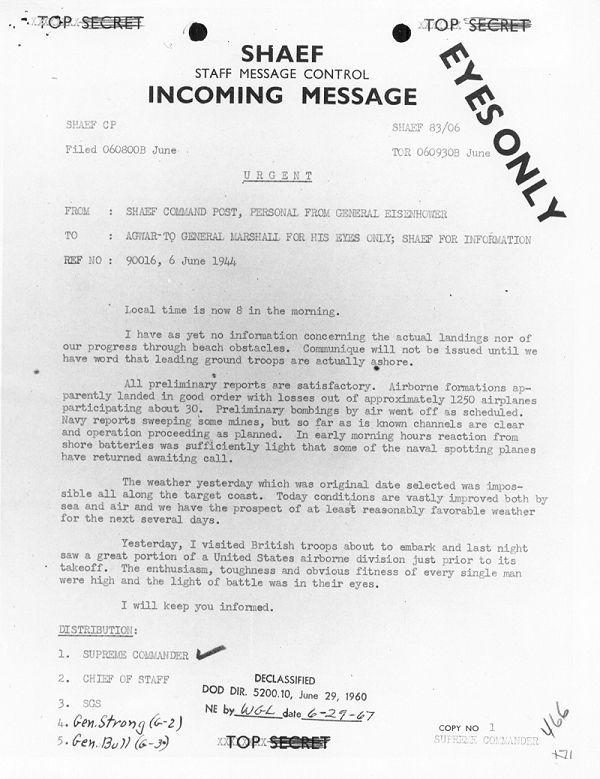With interest in Flames of War increasing I thought it would be a good idea to go over some of the "fluff." Here's a thing. It's the first message sent from General Eisenhower to General Marshall on the morning of 6 June 1944. I obtained it from the National Archives and Records Administration. Digital history FTW. Have a read:
First we note that it's from SHAEF--Supreme Headquarters Allied Expeditionary Force. This was the allied command for all U.S., U.K., Canadian, and French forces. It called the shots and Eisenhower was in charge. The ability of the allies to coordinate grand strategy was a real strength of the alliance.
The next thing we see is that the telegram is for General Marshall. He was the head of the U.S. Joint Chiefs of Staff-- the #1 military man in the U.S. He was Eisenhower's boss and reported directly to Roosevelt. Marshall developed U.S. strategy and Roosevelt signed off on it. Marshall was a nice guy. He bombed the shite out of Europe and then helped rebuild it after the war with the plan that bore his name. "Eyes Only" means Marshall is the only one who was supposed to read this.
O.k., let's get get to the content of the telegram. Eisenhower says it's 8:00 a.m. local time. The airborne operations were about seven hours old at this point, but the first troops to hit the beaches had only been on the ground for ninety minutes. Eisenhower explains, "I have as yet no information concerning the actual landings nor our progress through beach obstacles." In other words, he doesn't know what the situation is. Eisenhower was a chain smoker--four packs a day! Who can blame him? He was responsible for the lives of hundreds of thousands of soldiers. The next line is, however, quite chilling: "Communique will not be issued until we have word that leading ground troops are actually ashore." What does this mean? It means that the entire operation--an invasion of 160,00 troops--is going to be kept secret if it fails. Back in August 1942 five thousand Canadians invaded Dieppe. Fifteen hundred died and the Germans captured over two thousand. It was a disaster. Yet according to Allied news reports the plucky Canadians accomplished their objectives and returned to England for some well-deserved R&R. A nice way to describe an operation that failed utterly and resulted in over 60% casualties. Eisenhower is leaving open the possibility of failure on D-Day: June 7 newspaper headlines of a few thousand casualties from a training exercise. What would have happened if D-Day failed? To Eisenhower on the morning of June 6 it's a real possibility. Stick that in your counter-factual pipe and smoke it.
The middle paragraph contains some good information. It informs us that 1250 aircraft were involved in airborne operations and that the losses, as far as he knows, were very light. Mine-sweeping operations and preliminary bombardments appear to have went off without a hitch.
The last paragraph of the telegram is also noteworthy. We've all seen this photo:
Now you know what Eisenhower was thinking. In his diary on June 3, 1944, Eisenhower wrote, "Probably no one who does not have to bear the specific and direct responsibility of making the final decision as to what to do can understand the intensity of these burdens."
Labels: BristolScale7, Flames of War, Fluff, History
